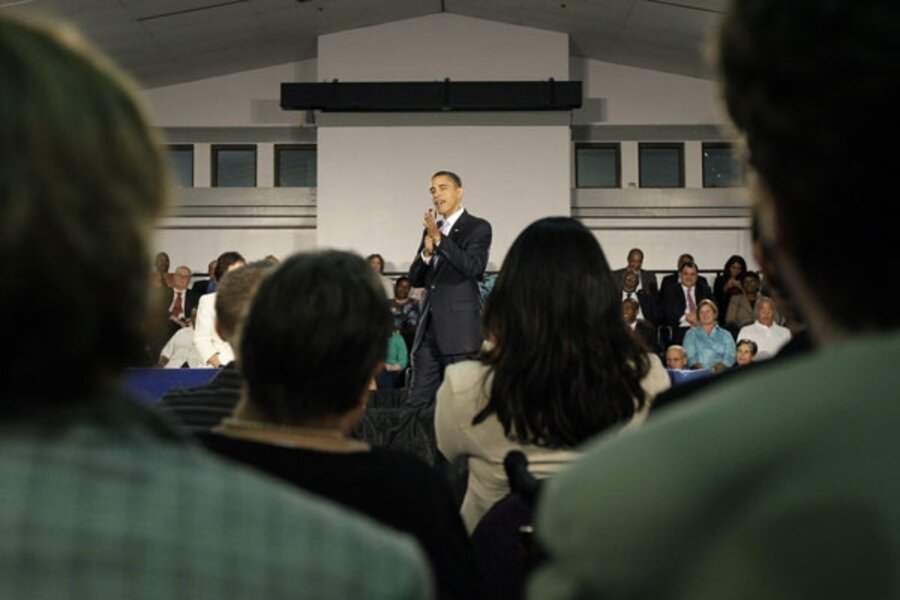A hot button in healthcare reform: US role as insurance provider
Loading...
| Washington
Two Senate panels are closing in on the toughest unresolved issue in healthcare reform: the scope of a public role in providing insurance.
What’s not on the table as the Senate reconvenes next week is a government-run, single-payer plan – an option backed by some 80 House Democrats but not by their party leadership.
President Obama favors having a government-run plan compete for customers alongside private insurers. But moving from an employer-based system of private insurance to a single-payer system run by the government “could be hugely disruptive,” he said at a town-hall meeting in Annandale, Va., on Wednesday.
“My attitude has been that we should be able to find a way to create a uniquely American solution to this problem that controls costs but preserves the innovation that is introduced in part with a free-market system,” he said.
If not single-payer, then what?
Debate over alternatives to the single-payer approach is taking place primarily within Democratic ranks. In a new draft plan, the Senate Health, Education, Labor and Pensions (HELP) Committee is calling for a public option to pool purchasing power, reduce administrative costs, and expand coverage to all Americans.
This Community Health Insurance Option, to be run by the Department of Health and Human Services, could leverage lower payment rates and aggressively promote quality care, sponsors of the idea say.
“Even in the face of scare tactics and false claims that a public option would destroy consumer choice or the insurance industry, a vigorous public option is what Americans want,” said HELP panel chair Edward Kennedy (D) of Massachusetts and acting chair Christopher Dodd (D) of Connecticut in a July 1 letter to panel members outlining the plan.
But the Senate Finance Committee, which must find a funding stream for the reforms, is so far focused on alternatives that could win bipartisan support. These include state or regional health insurance “coops” and a “trigger option” that defaults to a public option if reforms fail to give uninsured Americans choices they can afford.
Senator Schumer's 'level playing field'
On Wednesday, Sen. Charles Schumer (D) of New York turned up the heat on the issue as he announced that he would present a “level playing field” public option as an alternative to the bipartisan plan likely to come out of the committee.
“Any plan absolutely must be available to all Americans from the first day in order to successfully keep private insurers honest,” he said in a statement Wednesday. A keynote of this plan would be to require the public insurance option to meet the same rules and requirements as private plans.
The case for no public option at all
But private insurers, who strongly oppose public options, say the concept of a “level playing field” is a myth.
“Government today underpays for Medicare and Medicaid services. The only way hospitals can stay in business is to charge private insurers 130 percent of costs to offset the underpayments for government programs,” says Robert Zirkelbach, a spokesman for America’s Health Insurance Plans (AHIP), the insurance industry’s lobby.
Industry stakeholders already agree on a mix of reforms that satisfy much of the demand for a public option, he adds. These include guaranteeing coverage for preexisting health conditions, curbing premium hikes based solely on health status, requiring personal health insurance coverage, and expanding the safety net so that no one falls through the cracks.
“This model has broad support among stakeholders and policymakers. Talk of a public option crowds out the fact that there is a workable model to reform the healthcare system,” he adds.
How the public sees it ... so far
Sixty-nine percent of voters say Americans should have the option of government-run health insurance plan, but only 28 percent say they want to be covered by it, according to a Quinnipiac University poll released Wednesday.
"American voters want their fellow countrymen to have the option of a public plan, but don't want a public plan for themselves because they are satisfied personally with their healthcare," said Peter Brown, assistant director of the Quinnipiac University Polling Institute. "That presents a challenge to those who want Americans to pay more to reform the system."
Nearly 3 in 4 said they didn’t want to fork out more than $500 a year to pay for it.





